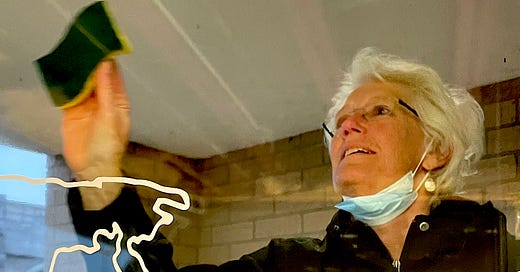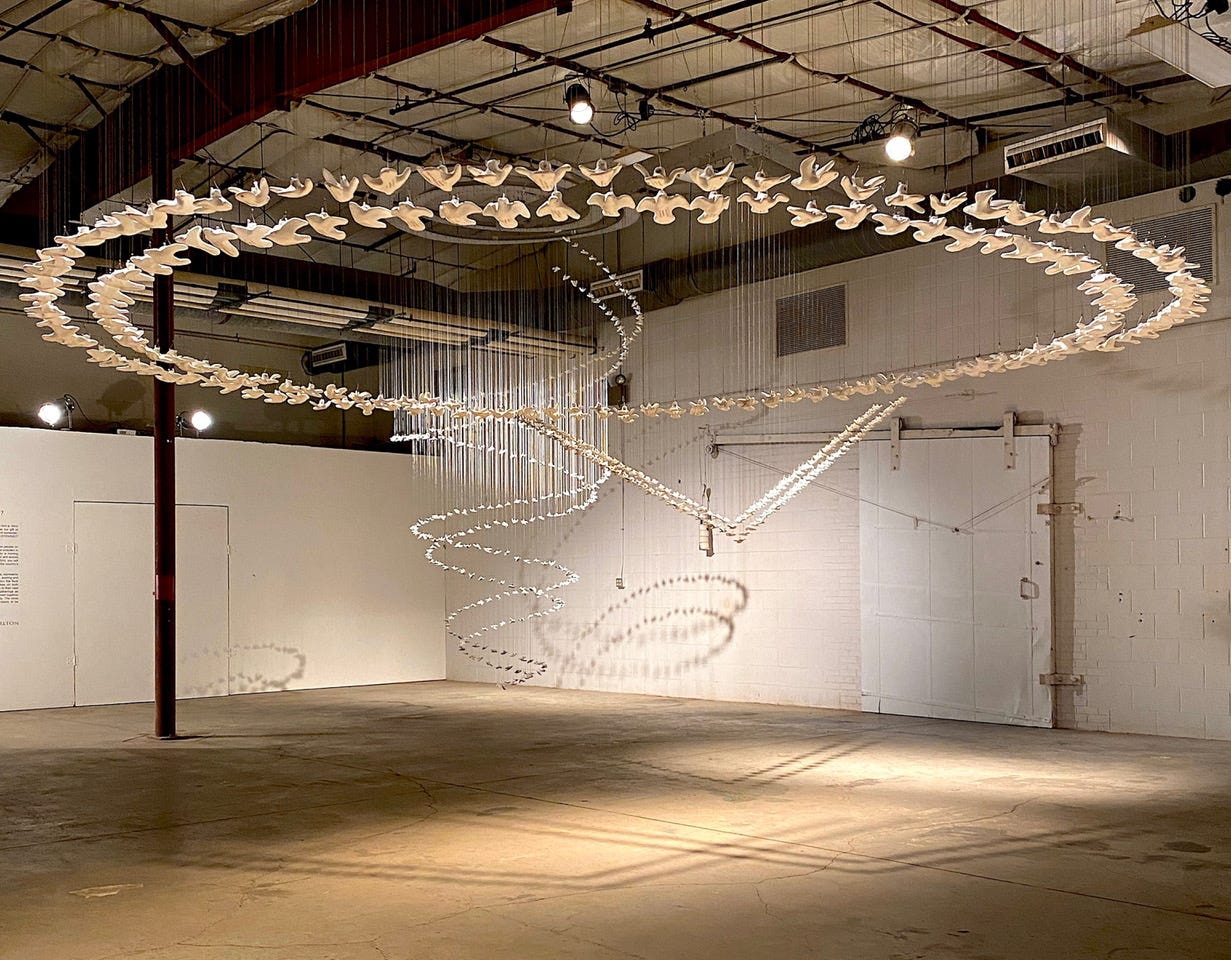In each issue of the Artists 4 Democracy newsletter, we share actions that you as an artist can take to help strengthen our democracy. We also profile an artist whose work reflects democratic values. Want to support our work on college campuses happening right now? Donate!
ACTION ITEM
How to tell Democrats from Republicans and why you should
The November 5 election is less than a month away, and there are four things you need to start working on today:
Research your ballot
Find out when and where to vote (vote.org)
Vote as early as you can
Then help everyone you know vote too
Researching your ballot can be challenging, because Democrats and Republicans look and sound a lot like each other in their campaign materials. The truth is there are very big differences between them on many issues. When voting, your best strategy is to choose candidates based on the issues you care about.
Policy differences between the two parties are very visible when you look at the state legislature,1 which is like Congress, but for your state. In the November 5 election, you'll be voting for President and a lot of other political races, including your representatives in your state legislature.
Below are three charts showing the impact of policy differences between states where the majority of the legislature is Democratic compared to states where the majority is Republican.
Gun deaths
On any average day in America, 132 people are killed by firearms. Those deaths are not evenly distributed across the states:
Abortion rights
When the Supreme Court announced their “Dobbs decision” ending national protections for abortion, they left it to each state to decide the law for the people who live there. Since then, some state legislatures have made abortion illegal while others have expanded access:
Minimum wage
The last time the national minimum wage was increased was in 2009, to $7.25 per hour. Today you’d need $10.57 to buy the same amount of stuff. Most Democratic majority states have a minimum wage above $10.57. Most Republican majority states don’t:
If you want to learn more, download the data about this and other critical issues, and do your own analysis.
For more help researching your ballot, check out A4D's nonpartisan Your Plan to Vote zines. We have customized editions for California, Pennsylvania, Arizona, Nevada, Georgia, North Carolina, Maine, and Kentucky, with more on the way. Download and print, or share them electronically with anyone you know who might need them.
On the same page check out GOTV zines made by students at the University of Nevada Las Vegas and Cal State LA. Smart, adorable, and eminently shareable. With hands-on activities inside!
ANOTHER ARTIST FOR DEMOCRACY
Rebecca Carlton
“How do we make sure that every person’s voice is heard? That we are all treated with honor and dignity, possibility and opportunity.”
As an artist, Rebecca Carlton is more interested in process than product. Trained as a sculptor and art historian, she is deeply influenced by performance or “happening” art. While she creates things that are solid and physical, she is more interested in how people interact with her work, and in “those moments we oftentimes miss because we are in such a hurry to get to our destination.”
Carlton grew up in California and lived in different parts of Arizona for several decades. Today she lives and makes art in rural Door County, Wisconsin, a bellwether county of 30,500 people where the majority has voted for the candidate who won the presidency in every election (except one) since 1980. Right now, she says, she’s seeing more signs on the side of the roads for Kamala Harris than the other guy.
Asked to define democracy, she says one word: justice. “I’ve been concerned about injustice since I was 10 or 11 years old.” Some of her earliest memories are the assassinations of Martin Luther King, Jr., and Robert F. Kennedy. “Those experiences imprinted on me.”

Door County is a narrow peninsula that juts out into Lake Michigan and has more than 300 miles of shoreline. The population booms each summer with 2.5 million visitors, most from the Midwest. The county punches above its weight in the arts, home to more than one hundred galleries, museums, and performing arts venues. “It’s hard to make a living as an artist here, but it’s easier than anywhere else I’ve lived,” Carlton says.
She is particularly aware of the number of women artists, women running business, and women leaders in Door County, describing the area as a place that allows women to fulfill their dreams and take risks. “There’s something here that lends itself to endless possibilities.”
Living in a tight-knit community means that when elections roll around, when Door County residents are voting for offices like Sheriff or County Board of Supervisors, they are voting for people they know personally. “You know their integrity and their record.”
In the spring of 2024, Carlton assembled an installation made up of 700 hand-made porcelain homing pigeons suspended on wires in three separate flight patterns, each pigeon representing ten percent of the world’s 7,000 languages. It was accompanied by a world map of languages and an audio recording of people saying the title of the exhibition, “Are We Listening?” in many of those languages. The installation in the county seat, Sturgeon Bay, was not the end of this project but turned out to be the beginning. Throughout spring and summer she organized 25 different talks, panel discussions, readings, and workshops that happened in the room under the installation, designed to bring people together from across Door County and beyond, to truly listen to each other.
When 9/11 happened in 2001, Carlton was working as a teaching artist in a Tucson elementary school. Seeking to teach her students how they could do something positive and proactive in response to a major global event, she taught them how to make clay hearts. On the back of each heart they made, the students wrote, From our hearts to yours, love [student name]. She let the students vote on what color to glaze them, and they chose red, white, and blue. It took some doing and working her network, but eventually the hearts found their way to the victims’ families. Soon, she began receiving letters from them, many of which she read over the intercom at school.
“That’s the power of art,” says Carlton. “It’s about an image and what that image carries, the intention of that image.” She thinks about those students today and wonders how their lives may have been affected by participating in that project.

When it comes to social justice issues, Carlton describes herself as “one of the worker bees” behind the scenes. She typed and mailed out the monthly “peace calendar” as part of the sanctuary movement in Tucson. She volunteered at a food kitchen with her sons for a year. She was a peacekeeper at pro-choice rallies more than 40 years ago. She remembers joining in demonstrations for lesbian and gay rights on Hollywood Boulevard in the 1970s that felt more like street parties.
So much of what artists can do for democracy are small and short term, “but by doing them we can change our perspective and broaden our understanding of the rest of the world.” Join a club, she says, or just go to one meeting. Engage with people who are different from you. At the very least, try to do the least harm in the world that you can do, in your daily life and when you vote.
Rebecca Carlton’s public art, Sonoran Circumvolution and Dragons of Character, are on permanent display in Tucson, Arizona. She has been a fellowship recipient from the National Endowment for the Arts, the Getty Center for the Arts, and the Fulbright Fund. Visit her and see her work at Juddville Contemporary Clay Studio and Gallery.
Thanks for reading the Artists 4 Democracy Newsletter. Artists 4 Democracy promotes democratic and civic engagement by mobilizing artists to get involved in political action. Through voter registration drives, fundraisers, and events we seek to foster and protect our participatory democracy.
A4D is run 100% by artist volunteers. If you’d like to contribute to our in-person work on college campuses (here’s one example!) this fall, please donate here.
Most states have a bicameral (“two houses”) legislature made up of the State Senate and the State House. (Five states call their House the State Assembly). Nearly 7,400 elected representatives serve in state Senates and Houses/Assemblies.








